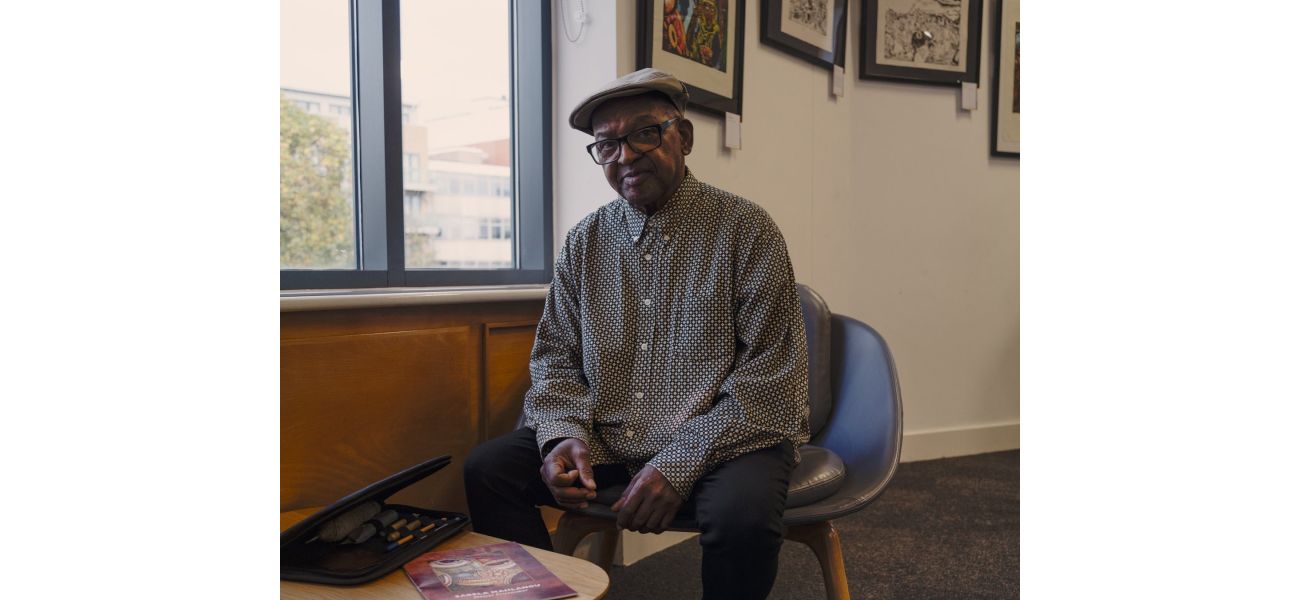Apartheid-defying artist in South Africa achieves major success.
Sabela Mahlangu had to obtain a permit just to access his studio when he started as an artist.
October 28th 2024.

Sabela Mahlangu's incredible journey as an artist is now being celebrated in Stratford as a part of Black History Month. But it wasn't always this way. When Sabela first began his artistic career, he needed a permit just to go to his own studio. It's hard to imagine now, as his prints and etchings are being exhibited in London, but the road to recognition has been filled with obstacles and challenges.
Born in 1951 near Johannesburg, shortly after apartheid was implemented, Sabela and his family were among the 3.5 million Black Africans who were forced to leave their homes and move into segregated townships. These neighborhoods were often far from their previous homes and were strictly separated from the white communities.
As a young man, Sabela was expected to find low-skilled manual labor. But deep down, he knew he had a talent for art. He first discovered this passion in high school and then went on to study at the prestigious Rorke's Drift art college, which was founded by Swedish missionaries with the goal of nurturing Africa's unique artistic heritage.
However, the road to becoming a successful artist was far from easy for Sabela. He shared with Metro the frustration he felt after spending years learning the tools of his trade, only to be told by an official that he should go work in a factory instead. The government's strict laws and policies made it nearly impossible for Black artists to thrive and succeed.
During this time, South Africa's legal system divided people into four racial categories, which dictated where they could live, work, and even who they could marry. Police regularly checked Black people's papers to ensure they were authorized to be where they were and doing what they were doing. This meant that Sabela could even be arrested for simply creating art in his own township without proper documentation.
Sabela recalled one instance where he had to queue up at a municipal office every day for a week just to obtain a "daily labor certificate" that proved he was allowed to work as an artist. But even after obtaining this document, he still had to constantly reapply and be prepared to show it to the police. This was just one example of how the white majority controlled and oppressed the Black population.
The apartheid laws in South Africa were incredibly restrictive and oppressive. They were implemented in 1948 and split South Africans into four groups: Black, White, Coloured, and Indian. These laws prevented these groups from interacting with one another, and Black people were forced to live in townships and obtain permits to travel within their own country.
One of the most notorious laws was the Bantu Authorities Act of 1951, which banned Black people from living in urban areas. This, along with other legislation, including the Immorality Amendment Act and the Group Areas Act, had a profound impact on Sabela's life and work.
It's no wonder that Sabela's latest exhibition is titled "If you are Black, you're not simply an artist." This title speaks to the barriers and challenges that Black artists faced during this time, while their white counterparts did not experience such limitations.
But despite all of these obstacles, Sabela persevered. His technique of etching on multiple copper plates and then printing them together with a single color is a laborious and time-consuming process that can take years to produce a single work. But Sabela's dedication and passion for his craft kept him going.
He needed to find a way to make his work commercially viable in order to sustain himself, but even after obtaining the necessary permits, there were still barriers. In order for a Black artist to have their work displayed in a gallery during apartheid, they needed to have connections with a white artist. This was just another example of how the system was designed to keep Black artists from succeeding.
In 1996, Sabela and his wife Judith, a nurse, relocated to Forest Gate in east London. And now, his prints depicting daily life in the townships are being celebrated as a part of Black History Month at the Stratford Library in Newham. Sabela's work has also been exhibited at the Africa Centre earlier this year.
His prints have been sold to numerous universities in South Africa, as well as the United Nations permanent collection in New York and the British Museum. In an academic article, Sipho Mdanda of the University of Johannesburg referred to Sabela as an "introverted genius," whose mastery of printmaking has benefited artists of all races, despite the strict apartheid laws.
Sabela's latest exhibition can be seen at Stratford Library until October 30th. It's a testament to his perseverance and determination to pursue his passion, despite the challenges and barriers he faced. Sabela's story is a reminder of the power of art to transcend boundaries and bring people together, even in the face of oppression and discrimination.
Born in 1951 near Johannesburg, shortly after apartheid was implemented, Sabela and his family were among the 3.5 million Black Africans who were forced to leave their homes and move into segregated townships. These neighborhoods were often far from their previous homes and were strictly separated from the white communities.
As a young man, Sabela was expected to find low-skilled manual labor. But deep down, he knew he had a talent for art. He first discovered this passion in high school and then went on to study at the prestigious Rorke's Drift art college, which was founded by Swedish missionaries with the goal of nurturing Africa's unique artistic heritage.
However, the road to becoming a successful artist was far from easy for Sabela. He shared with Metro the frustration he felt after spending years learning the tools of his trade, only to be told by an official that he should go work in a factory instead. The government's strict laws and policies made it nearly impossible for Black artists to thrive and succeed.
During this time, South Africa's legal system divided people into four racial categories, which dictated where they could live, work, and even who they could marry. Police regularly checked Black people's papers to ensure they were authorized to be where they were and doing what they were doing. This meant that Sabela could even be arrested for simply creating art in his own township without proper documentation.
Sabela recalled one instance where he had to queue up at a municipal office every day for a week just to obtain a "daily labor certificate" that proved he was allowed to work as an artist. But even after obtaining this document, he still had to constantly reapply and be prepared to show it to the police. This was just one example of how the white majority controlled and oppressed the Black population.
The apartheid laws in South Africa were incredibly restrictive and oppressive. They were implemented in 1948 and split South Africans into four groups: Black, White, Coloured, and Indian. These laws prevented these groups from interacting with one another, and Black people were forced to live in townships and obtain permits to travel within their own country.
One of the most notorious laws was the Bantu Authorities Act of 1951, which banned Black people from living in urban areas. This, along with other legislation, including the Immorality Amendment Act and the Group Areas Act, had a profound impact on Sabela's life and work.
It's no wonder that Sabela's latest exhibition is titled "If you are Black, you're not simply an artist." This title speaks to the barriers and challenges that Black artists faced during this time, while their white counterparts did not experience such limitations.
But despite all of these obstacles, Sabela persevered. His technique of etching on multiple copper plates and then printing them together with a single color is a laborious and time-consuming process that can take years to produce a single work. But Sabela's dedication and passion for his craft kept him going.
He needed to find a way to make his work commercially viable in order to sustain himself, but even after obtaining the necessary permits, there were still barriers. In order for a Black artist to have their work displayed in a gallery during apartheid, they needed to have connections with a white artist. This was just another example of how the system was designed to keep Black artists from succeeding.
In 1996, Sabela and his wife Judith, a nurse, relocated to Forest Gate in east London. And now, his prints depicting daily life in the townships are being celebrated as a part of Black History Month at the Stratford Library in Newham. Sabela's work has also been exhibited at the Africa Centre earlier this year.
His prints have been sold to numerous universities in South Africa, as well as the United Nations permanent collection in New York and the British Museum. In an academic article, Sipho Mdanda of the University of Johannesburg referred to Sabela as an "introverted genius," whose mastery of printmaking has benefited artists of all races, despite the strict apartheid laws.
Sabela's latest exhibition can be seen at Stratford Library until October 30th. It's a testament to his perseverance and determination to pursue his passion, despite the challenges and barriers he faced. Sabela's story is a reminder of the power of art to transcend boundaries and bring people together, even in the face of oppression and discrimination.
[This article has been trending online recently and has been generated with AI. Your feed is customized.]
[Generative AI is experimental.]
0
0
Submit Comment





